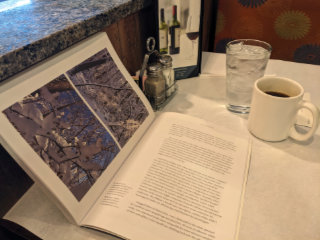 The year Kevin Patrick spent “connecting with White’s Woods” may have been, as a blurb on the back of Near Woods says “In the spirit of Walden” but the resulting products are not the same. Thoreau’s time at Walden Pond was an experiment in self-sufficiency and the book he wrote some years later documented its success. His observations of nature and seasons were generally used to support some aspect of his minimalist lifestyle and not to educate the reader. I suppose some of Patrick’s observations are also made to reinforce some philosophical viewpoint, but he is a lot more subtle and he helps the reader share the raw observation as near as possible. Exactly one-half of this book’s pages are filled with some excellent photographs.
The year Kevin Patrick spent “connecting with White’s Woods” may have been, as a blurb on the back of Near Woods says “In the spirit of Walden” but the resulting products are not the same. Thoreau’s time at Walden Pond was an experiment in self-sufficiency and the book he wrote some years later documented its success. His observations of nature and seasons were generally used to support some aspect of his minimalist lifestyle and not to educate the reader. I suppose some of Patrick’s observations are also made to reinforce some philosophical viewpoint, but he is a lot more subtle and he helps the reader share the raw observation as near as possible. Exactly one-half of this book’s pages are filled with some excellent photographs.
The word “spirit” also appears early in the book’s text. There Patrick says it is written in the spirit of other nature books and mentions, in addition to Thoreau, Emerson, Muir, Cousteau, and others. I believe what he means is the sharing of observations as accurately as possible and in a manner that promotes a real appreciation of what is being observed.
I’m not all that familiar with many of the authors named but did find myself making some comparisons with an author and book Patrick does not mention. In PrairieErth, William Least Heat Moon makes a deep dive into a single county in Kansas. In some sense, Patrick’s deep dive into the 250-acre White’s Woods is closer to Moon’s product than to Thoreau’s but that comparison is also far from perfect. By trying to look at that county from every possible angle, PrairieErth can sometimes seem like a writing class exercise. Near Woods looks at its subject from a lot of angles but not, I think, every angle. Just the interesting ones.
 Of course, Near Woods is better looking than either Walden or PrairieErth. To some degree, that’s just something that color photographs do for a book. But these high-quality and well-chosen photos do more than make the book pretty. They are the “raw observations” mentioned in the first paragraph of this article. The book’s design incorporates the photos wonderfully and helps make reading the book a pleasure. Every lefthand page contains one or more photographs. Righthand pages are all text. Captions are in the extra wide inner margins of the text pages. It didn’t take me terribly long to recognize the beauty of this. Every page turn resulted in a new image that could be studied as quickly or slowly as desired before tackling a new page of text.
Of course, Near Woods is better looking than either Walden or PrairieErth. To some degree, that’s just something that color photographs do for a book. But these high-quality and well-chosen photos do more than make the book pretty. They are the “raw observations” mentioned in the first paragraph of this article. The book’s design incorporates the photos wonderfully and helps make reading the book a pleasure. Every lefthand page contains one or more photographs. Righthand pages are all text. Captions are in the extra wide inner margins of the text pages. It didn’t take me terribly long to recognize the beauty of this. Every page turn resulted in a new image that could be studied as quickly or slowly as desired before tackling a new page of text.
Sometimes there is a direct connection between text and photo and sometimes the connection is loose or non-existent. At one point a loose connection led me to believe that Kevin had cheated me or at least made a major goof. One of the more interesting finds in White’s Woods is a quad-trunk tulip tree. I really wanted to see this oddity as I read about it but the pictures next to the text were of something else entirely. A photo of the tulip tree in winter appears a page or two later and I realized that this is the image on the book’s back cover. The front cover shows this extraordinary tree in summer. I wasn’t cheated and the goof was all mine. Doh!
Photographs show the woods through one year of its life and the four seasons are used to organize the book. The woods’ history and possible future are mixed into the reporting of seasonal changes to provide some very pleasant lessons in natural and human history, horticulture, geography, and geology.
Near Woods: A Year in an Allegheny Forest, Kevin Patrick, Stackpole Books (May 1, 2023), 8.5 x 11 inches, 258 pages, ISBN 978-0811772211
Available through Amazon.
